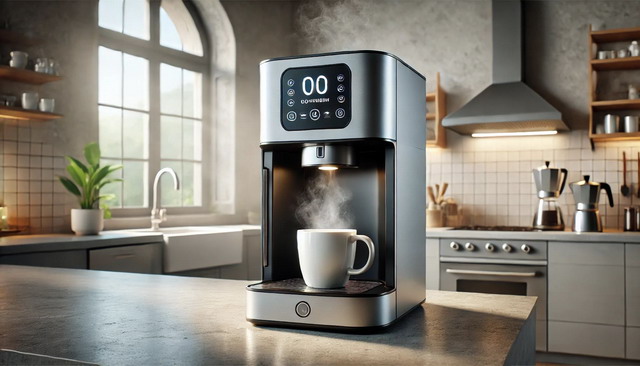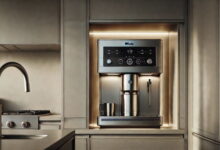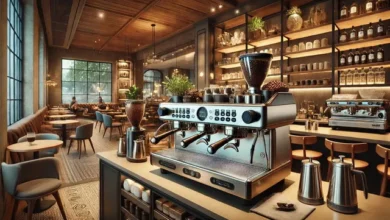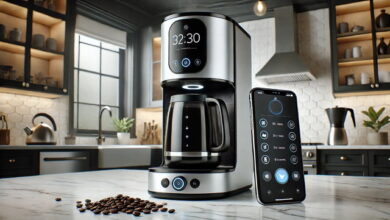Energy-Efficient Coffee Makers 2025: Save Energy & Brew Smarter
In the ever-evolving world of household appliances, few have garnered as much attention in recent years as the coffee maker. A staple in homes and offices worldwide, the coffee maker is now undergoing a transformation driven by growing consumer awareness of sustainability. As we step into 2025, energy-efficient coffee makers are no longer a luxury but a necessity for eco-conscious consumers who are mindful of their energy consumption and the environmental impact of their daily caffeine fix.
In this post, we will explore why energy-efficient coffee makers have become so essential, what features to look for, and how they can make a positive difference in both your energy bills and the environment.
1. The Growing Demand for Energy-efficient Coffee Makers
The world is becoming more eco-conscious, and this shift is reflected in the way people purchase and use household appliances. Among the myriad of gadgets and devices that populate modern homes, the coffee maker is one of the most frequently used. With millions of people brewing coffee every day, the environmental impact of inefficient coffee machines is becoming increasingly apparent. In 2025, energy efficiency is no longer just about cutting costs—it’s about sustainability, reducing carbon footprints, and preserving resources for future generations.
Consumer Awareness and Environmental Concerns
In recent years, climate change has sparked a global conversation about energy consumption and environmental responsibility. Consumers are now more informed than ever about how their choices impact the planet. A growing number of individuals and businesses are prioritizing energy-efficient appliances, not only because of the potential cost savings but also due to the larger environmental benefits.
This awareness is particularly evident in the coffee-making industry. According to recent studies, the average household brews multiple cups of coffee per day, with the coffee maker often left on for extended periods, consuming a surprising amount of energy. As more people adopt sustainable habits, the demand for energy-efficient coffee makers has surged.
Governments and environmental agencies are also playing a role in this shift, offering incentives for purchasing energy-efficient appliances. Many coffee makers now carry the coveted Energy Star certification, a badge of honor for appliances that meet rigorous standards for energy efficiency. This certification not only assures consumers that they are making a greener choice, but also highlights the increasing importance of reducing energy consumption in everyday life.
A Shift in Consumer Preferences
Another driving force behind the rising demand for energy-efficient coffee makers is the change in consumer preferences. Today’s consumers are not just looking for convenience and a great cup of coffee; they also want to know that their appliances are sustainable and eco-friendly. This is particularly true for millennials and Gen Z, who are leading the charge in adopting greener lifestyles. These generations are more likely to research the energy efficiency of products before making a purchase and are willing to pay a premium for appliances that align with their values.
This shift in mindset is leading to a new era of coffee maker innovation. Manufacturers are responding by introducing energy-efficient models that not only reduce energy usage but also incorporate sustainable materials, smart features, and eco-friendly brewing methods.
2. What to Look for in the Best Energy-efficient Coffee Makers of 2025
With the growing interest in energy-efficient coffee makers, it’s important to know what features to look for when making a purchase. Not all coffee makers are created equal, and some are far better than others in terms of energy consumption. In 2025, the best energy-efficient coffee makers combine cutting-edge technology with smart design to offer consumers the perfect balance between performance and sustainability.
Key Features of Energy-efficient Coffee Makers
When shopping for an energy-efficient coffee maker, there are a few key features that you should consider to ensure you’re getting the best performance with the lowest environmental impact:
- Energy Star Certification: As mentioned earlier, this is the gold standard for energy-efficient appliances. Coffee makers with Energy Star certification are designed to use less electricity without sacrificing performance. These models typically use about 30% less energy than standard models, making them an excellent choice for eco-conscious consumers.
- Auto Shut-off: One of the simplest yet most effective energy-saving features is auto shut-off. Many coffee makers in 2025 come equipped with this feature, which automatically turns off the machine after a certain period of inactivity. This not only helps to reduce energy consumption but also provides peace of mind for users who often forget to turn off their machines after brewing a cup.
- Programmable Timers: A programmable timer allows users to set the coffee maker to start brewing at a specific time. This not only ensures that your coffee is ready when you wake up, but it also prevents the machine from being left on unnecessarily. Some models even allow you to schedule brewing times through a smartphone app, offering even more control over your energy usage.
- Low-wattage Heating Elements: Some of the most energy-efficient coffee makers are designed with low-wattage heating elements that consume less power while still maintaining optimal brewing temperatures. This feature can significantly reduce the overall energy consumption of the machine without compromising the quality of your coffee.
- Reusable Filters: Another aspect of energy efficiency is waste reduction. Many energy-efficient coffee makers come with reusable filters, which not only cut down on waste but also reduce the energy needed to produce and dispose of single-use paper filters. This is a small but meaningful way to reduce the environmental footprint of your coffee routine.
The Technology Behind Energy Efficiency
The coffee makers of 2025 are powered by advanced technology that is designed to optimize energy use. For example, some models use “pulse brewing” technology, which heats water in short bursts rather than keeping the heating element on continuously. This method reduces energy consumption while still producing a rich, flavorful cup of coffee.
Another innovative feature found in energy-efficient coffee makers is the use of insulated carafes. These thermal carafes help keep coffee hot for longer periods without the need for a hot plate, which is one of the most energy-intensive components of traditional coffee makers. By using insulation instead of heat, these coffee makers can drastically reduce the amount of electricity they consume.
Long-term Savings and Environmental Impact
While energy-efficient coffee makers may have a higher upfront cost, they offer significant long-term savings on your energy bills. Over time, the reduced energy consumption can offset the initial investment, making these machines a smart choice for both your wallet and the planet. Additionally, by reducing your energy use, you’re contributing to a larger effort to combat climate change and reduce the demand on the power grid.
3. Top 10 Energy-saving Coffee Makers for Small Offices and Homes
As we delve deeper into 2025, energy-saving coffee makers are a hot commodity for both homes and small offices. Whether you’re brewing for one or ten, these devices can significantly reduce your electricity consumption while still delivering that much-needed caffeine kick. Below, we highlight the top 10 energy-efficient coffee makers designed for small-scale use, providing a perfect blend of functionality, sustainability, and style.
- Breville Precision Brewer Thermal
- Key Feature: Adjustable brewing modes, thermal carafe.
- Why It’s Energy-efficient: Brews coffee quickly using a low-power heating element and keeps it warm for hours with an insulated carafe, eliminating the need for a hot plate.
- Technivorm Moccamaster KBGV Select
- Key Feature: Quiet operation, auto shut-off.
- Why It’s Energy-efficient: With its precision heater and energy-saving auto shut-off, this model delivers great coffee without excessive energy consumption.
- Nespresso Vertuo Next
- Key Feature: Recyclable pods, automatic shut-off.
- Why It’s Energy-efficient: Its energy-efficient design, combined with recyclable coffee pods, minimizes both energy use and environmental waste.
- Cuisinart DCC-3200P1 Perfectemp
- Key Feature: Adjustable brew strength, auto shut-off.
- Why It’s Energy-efficient: The programmable shut-off feature ensures that the machine doesn’t stay on longer than necessary, saving power during idle periods.
- OXO Brew 9 Cup Coffee Maker
- Key Feature: Double-walled carafe, precise temperature control.
- Why It’s Energy-efficient: The insulated carafe keeps coffee warm without requiring a hot plate, significantly reducing energy use.
- Hamilton Beach FlexBrew Single Serve
- Key Feature: Dual brewing options (K-Cup or ground coffee).
- Why It’s Energy-efficient: Designed to brew a single cup on demand, it avoids the energy waste of brewing a full pot for one person.
- Keurig K-Elite
- Key Feature: Energy-efficient brew cycle, strong brew setting.
- Why It’s Energy-efficient: Features an automatic energy-saving mode that powers down the machine when idle for an extended period.
- Mueller Ultra Brew Thermal Coffee Maker
- Key Feature: Programmable brewing and thermal carafe.
- Why It’s Energy-efficient: The programmable timer and thermal carafe work together to minimize energy use while keeping coffee hot for hours.
- Mr. Coffee Optimal Brew
- Key Feature: Quick brew cycle, freshness indicator.
- Why It’s Energy-efficient: The fast brewing process uses less energy, and the automatic shut-off ensures that the machine isn’t running unnecessarily.
- Bonavita BV1900TS
- Key Feature: Thermal carafe, one-touch brewing.
- Why It’s Energy-efficient: This coffee maker uses an efficient 1500-watt heater that quickly reaches optimal brewing temperature, saving both time and energy.
Each of these coffee makers has been designed with energy-saving features that can help reduce electricity usage while maintaining the quality of your brew. Whether you’re looking for a model for your home or a small office setting, these coffee makers offer a perfect combination of sustainability and convenience.
4. Eco-friendly Coffee Machines with Low Power Consumption
Eco-friendliness and energy efficiency often go hand-in-hand, especially when it comes to appliances like coffee makers. In 2025, the demand for eco-friendly coffee machines that also boast low power consumption is growing as consumers become more aware of their carbon footprints. But what exactly makes a coffee machine eco-friendly? Let’s explore the key components of these machines and why they matter.
Sustainable Materials
Many of the most eco-friendly coffee makers are now being produced with sustainable materials, such as stainless steel, recycled plastics, and even bamboo. These materials not only reduce the environmental impact of manufacturing but also increase the durability and longevity of the machine. For example, stainless steel is known for its resistance to rust and wear, ensuring that the coffee maker lasts longer, reducing the need for frequent replacements.
Coffee machines designed with recycled or recyclable materials also contribute to a reduction in waste. By choosing a coffee maker that’s built to last and can be recycled at the end of its life cycle, you’re taking a step toward reducing your household’s overall waste production.
Low Power Consumption and Energy-efficient Brewing
Energy-efficient coffee makers with low power consumption typically feature innovative technologies designed to reduce the amount of electricity needed to brew each cup. These technologies include:
- Smart Power Management: Many coffee makers now come equipped with intelligent power management systems that adjust the machine’s energy use based on the size of the brew and the time it takes to complete.
- Heat Retention Systems: Machines with thermal carafes are particularly energy-efficient, as they rely on heat retention rather than a hot plate to keep the coffee warm. This significantly reduces the electricity needed after the brewing process is complete.
- Low-wattage Heating Elements: Some eco-friendly models use low-wattage heating elements that still deliver the necessary heat for brewing but consume less electricity in the process.
By reducing energy use, these machines help households lower their electricity bills and minimize their impact on the environment. These appliances also contribute to a broader effort to reduce global energy consumption, which is increasingly crucial as the world grapples with climate change and energy resource depletion.
5. Energy-efficient Coffee Makers for Large Offices: Reducing Power Usage
While homes and small offices benefit greatly from energy-efficient coffee makers, large offices present a unique challenge. Coffee consumption in these environments is typically higher, with machines often brewing throughout the day to meet the demands of dozens, or even hundreds, of employees. This can lead to significant energy use—unless the right coffee makers are in place. In 2025, many businesses are turning to energy-efficient models to help reduce their overall power consumption without sacrificing coffee quality.
Features for High-volume Use
When selecting an energy-efficient coffee maker for a large office, it’s important to focus on models specifically designed for high-volume use. Some of the key features to look for include:
- Large Capacity: Coffee makers with larger brewing capacities reduce the need for multiple brewing cycles, which can help save energy over the course of the day.
- Insulated Urns: Instead of using hot plates, many energy-efficient coffee makers for large offices use insulated coffee urns or airpots to keep the brew warm. This helps cut down on the energy required to maintain the coffee’s temperature.
- Rapid Brew Cycles: Machines with fast brewing times are ideal for busy offices, as they reduce the overall time the machine spends heating and brewing, leading to lower energy consumption.
Case Studies: Companies Leading the Way
Several companies have already made the switch to energy-efficient coffee makers with impressive results. For instance, a well-known tech company implemented energy-efficient coffee machines in their headquarters, reducing their overall coffee machine-related energy use by 25%. This not only helped lower their electricity bills but also contributed to their larger corporate sustainability goals.
Similarly, a large marketing firm in New York replaced their standard coffee makers with Energy Star-certified models, which featured programmable timers and automatic shut-off functions. The result was a significant reduction in energy consumption, helping the company achieve its green office certification.
Balancing Performance and Sustainability
For large offices, energy efficiency should not come at the cost of performance. The best energy-efficient coffee makers for this setting are those that can handle high brewing volumes while maintaining consistent coffee quality. Fortunately, 2025’s latest models manage to strike this balance, delivering robust performance without consuming excessive power.
6. The Role of Smart Technology in Energy-efficient Coffee Makers
Smart technology has revolutionized many aspects of our daily lives, and in 2025, it plays a pivotal role in making coffee makers more energy-efficient than ever. These smart coffee makers combine cutting-edge features with energy-saving functionality, making it easier for users to brew their favorite drinks while keeping energy consumption to a minimum.
Smart Coffee Makers: A New Era of Energy Efficiency
Smart coffee makers in 2025 are designed to connect to Wi-Fi, allowing users to control them remotely via smartphone apps. This convenience is not just about making coffee at the touch of a button; it’s also about optimizing energy use through automation and scheduling.
For example, you can schedule your coffee maker to start brewing just before you wake up, so it’s not running unnecessarily throughout the day. Some machines even learn your brewing habits and adjust their energy usage accordingly, turning off when they sense that you won’t need another cup for a while. These smart systems ensure that your coffee maker uses the least amount of energy possible while still delivering fresh, hot coffee when you want it.
Key Smart Features That Reduce Energy Use
- Auto Shut-off and Sleep Mode: One of the most significant energy-saving features in smart coffee makers is auto shut-off. After a preset period of inactivity, the machine automatically powers down to conserve energy. Some models also feature a sleep mode, where the coffee maker reduces power consumption without fully turning off, allowing for a quicker start-up when needed.
- Scheduling and Remote Operation: The ability to schedule brewing times or control the machine remotely is a major energy saver. You no longer need to leave your machine on all day in anticipation of your next cup. Instead, with a simple tap on your smartphone, you can turn the coffee maker on only when needed, reducing idle energy consumption.
- Energy-saving Brew Cycles: Many smart coffee makers use optimized brew cycles to minimize energy use. For instance, instead of continuously heating water, these machines pulse the heating elements or use insulation to maintain the water temperature for shorter periods. This efficient use of power results in a lower overall energy footprint.
Integration with Smart Home Systems
The rise of smart homes means that your coffee maker can now be integrated into a broader energy-saving ecosystem. By linking your coffee maker with other smart devices in your home, such as thermostats, lights, and appliances, you can automate its operation based on your daily routine. For instance, your smart home system might turn off the coffee maker when it senses that you’ve left for work or adjust its brewing schedule based on your typical wake-up time.
Smart home assistants, such as Amazon Alexa and Google Assistant, further enhance this experience. You can control your coffee maker with voice commands, ensuring that it’s only on when needed and automatically switches off to save energy when not in use.
7. Sustainable Coffee Brewing: The Environmental Benefits of Energy-saving Coffee Makers
In addition to saving energy, the best coffee makers in 2025 are designed with sustainability in mind. The move towards energy-efficient appliances is closely linked to broader environmental concerns, such as reducing carbon footprints, minimizing waste, and conserving resources. Coffee makers are no exception to this trend, with many models offering eco-friendly features that help reduce their overall environmental impact.
Lowering Your Carbon Footprint
The carbon footprint of a traditional coffee maker can be surprisingly high, especially if it’s left on for extended periods or uses inefficient heating elements. Energy-efficient coffee makers tackle this issue head-on by reducing electricity usage, which in turn lowers the amount of carbon dioxide emitted by power plants.
For example, an Energy Star-certified coffee maker uses up to 30% less energy than a non-certified model. Over time, this reduction can have a significant impact, particularly in households or offices where coffee is brewed frequently. By making the switch to an energy-efficient machine, you’re actively contributing to reducing greenhouse gas emissions.
Reducing Waste with Reusable Filters and Pods
One of the biggest environmental concerns surrounding coffee consumption is the waste generated by single-use coffee pods and paper filters. In 2025, many energy-efficient coffee makers are designed to address this issue by incorporating reusable filters or offering machines compatible with recyclable pods. These features help to minimize the waste associated with brewing coffee, making it easier for consumers to adopt more sustainable habits.
For instance, coffee makers with built-in stainless steel or gold-tone filters eliminate the need for disposable paper filters. Similarly, manufacturers like Nespresso are making strides in offering recyclable aluminum coffee pods that can be reused or sent back for recycling, further reducing waste in the coffee brewing process.
Sustainable Materials and Manufacturing
Another important aspect of sustainable coffee makers is the materials used in their construction. Many models now feature components made from recycled plastics or sustainably sourced metals. In addition, manufacturers are becoming more transparent about their production processes, ensuring that their coffee makers are built in environmentally friendly ways.
Some companies even go a step further by offering repairable models, which extend the life of the machine and reduce the number of appliances that end up in landfills. This shift towards sustainability not only helps the environment but also provides consumers with a more durable and long-lasting product.
Water-saving Technologies
Energy-efficient coffee makers also incorporate water-saving technologies, which is another critical component of sustainable brewing. These machines are designed to use just the right amount of water for each brew cycle, ensuring that no water is wasted. By optimizing water use, energy-efficient coffee makers contribute to conserving one of the planet’s most precious resources.
8. Energy Star Coffee Makers 2025: What Consumers Should Know
As energy efficiency becomes more important in consumer appliances, the Energy Star certification has emerged as a trusted symbol of sustainability. Coffee makers with this certification are held to strict standards that ensure they use less energy without sacrificing performance. In 2025, Energy Star coffee makers are widely available, offering consumers a reliable way to reduce their energy consumption.
What Is Energy Star Certification?
Energy Star is a program run by the U.S. Environmental Protection Agency (EPA) that certifies products meeting specific energy-saving criteria. To earn the Energy Star label, a coffee maker must undergo rigorous testing to ensure it meets the highest standards of energy efficiency. These machines are typically designed to use less power during brewing and feature energy-saving modes such as auto shut-off.
For coffee makers, Energy Star certification means the appliance uses around 30% less energy than standard models. This reduction is achieved through features like programmable timers, optimized heating elements, and insulated carafes that reduce the need for continuous heating.
Why Energy Star Matters in 2025
In 2025, energy-efficient appliances are more crucial than ever as the world grapples with climate change and rising energy costs. By choosing an Energy Star-certified coffee maker, consumers can be confident that they are making a smart investment for both their wallet and the planet.
Energy Star-certified coffee makers not only help reduce electricity bills but also contribute to a broader effort to reduce carbon emissions. In a typical household or office setting, switching to an Energy Star model can result in significant energy savings over time, especially for those who brew coffee frequently.
Comparing Energy Star Coffee Makers to Non-certified Models
The difference between Energy Star-certified coffee makers and non-certified models may not always be immediately noticeable, but the long-term benefits are clear. Certified models are designed to operate more efficiently, with features like:
- Faster brewing cycles: Less time spent heating water means less energy is used per cup.
- Auto shut-off and sleep modes: These features ensure that the coffee maker isn’t drawing power when it’s not in use.
- Better insulation: Many Energy Star models use insulated carafes to keep coffee warm without the need for a continuously powered hot plate.
While non-certified models may offer a lower upfront cost, they often use more energy in the long run, leading to higher electricity bills and a greater environmental impact. For consumers who prioritize sustainability and long-term savings, investing in an Energy Star-certified coffee maker is a smart choice.
9. Energy-efficient Coffee Machines with Recyclable Pods
As the world continues its shift towards sustainable living, coffee lovers are increasingly concerned with the environmental impact of single-use coffee pods. Traditional pods, made of plastic and aluminum, contribute to vast amounts of waste, with billions of pods ending up in landfills each year. Recognizing this issue, many manufacturers in 2025 have developed coffee machines that not only conserve energy but also work with recyclable pods, reducing the waste associated with the brewing process.
The Environmental Impact of Traditional Pods
Single-use coffee pods have long been a convenient option for many, especially in offices and homes where speed and ease are prioritized. However, the environmental toll of non-recyclable pods is significant. The majority of these pods are made from materials that are difficult to recycle, contributing to a massive accumulation of waste globally.
To address this, companies are rethinking their approach. In 2025, brands like Nespresso, Keurig, and Lavazza are leading the charge by producing recyclable or compostable coffee pods, offering eco-conscious consumers a way to enjoy their coffee without guilt.
Recyclable Pods: A Greener Option
Recyclable pods offer a sustainable alternative to their plastic counterparts. These pods are typically made from materials like aluminum, which can be easily processed and reused. Some companies are even designing pods made from biodegradable materials, which break down naturally and reduce waste.
Coffee machines that support recyclable pods also come with user-friendly systems that make it easy to recycle spent pods. For example, Nespresso has a pod recycling program where users can return used pods for recycling at no additional cost. This system ensures that more pods are properly disposed of and repurposed rather than being sent to landfills.
Energy Efficiency and Waste Reduction Combined
The integration of recyclable pods with energy-efficient coffee makers offers a holistic approach to sustainable brewing. Machines that brew with recyclable pods often feature other eco-friendly designs, such as low-wattage heating elements and smart auto shut-off features. This combination makes it easy for consumers to reduce both their energy consumption and their environmental impact, creating a more sustainable coffee culture overall.
10. How to Maintain Energy-efficient Coffee Makers for Maximum Efficiency
To ensure that your energy-efficient coffee maker operates at its best, regular maintenance is essential. Even the most advanced machines can lose their efficiency over time if not properly cared for. In this section, we’ll explore some key maintenance tips to help you get the most out of your coffee maker, saving energy and extending the lifespan of your appliance.
Cleaning for Optimal Performance
One of the simplest yet most effective ways to maintain your coffee maker’s efficiency is through regular cleaning. Over time, minerals from water and oils from coffee grounds can build up inside the machine, reducing its ability to heat and brew effectively. This buildup forces the machine to work harder, increasing its energy consumption.
To avoid this, it’s important to clean your coffee maker at least once a month. Most machines come with descaling instructions, allowing you to remove any limescale or mineral deposits that may have accumulated. Descaling agents or a mixture of water and vinegar can effectively clear these deposits, restoring the machine’s efficiency.
Replacing Parts When Necessary
Just like any other appliance, certain parts of a coffee maker will wear out over time, impacting its energy efficiency. Regularly inspect components like the heating element, water pump, and filters to ensure they are functioning correctly. Many energy-efficient coffee makers are designed with easy-to-replace parts, allowing you to keep your machine running smoothly without the need for costly repairs or replacements.
Replacing the water filter on a regular basis is another important maintenance step. A clogged or dirty filter can affect water flow, making the machine work harder to brew each cup, which increases energy use.
Proper Use of Energy-saving Features
Many coffee makers come equipped with energy-saving features such as auto shut-off, programmable timers, and sleep modes. To get the most out of these features, it’s essential to use them correctly. For example, set your machine to turn off automatically after brewing, and take advantage of programmable timers that only activate the machine when you need it. This ensures that the coffee maker isn’t left running unnecessarily, which can waste energy.
By maintaining your machine and using it as intended, you’ll maximize its energy efficiency and prolong its lifespan, saving both energy and money over time.
11. Future Innovations in Energy-efficient Coffee Makers
The coffee industry continues to evolve, with manufacturers pushing the boundaries of energy-efficient design and sustainable technology. As we look to the future, several innovations promise to further improve the energy efficiency and environmental impact of coffee makers in 2025 and beyond.
Advanced Insulation and Heat Retention
One area of innovation is the development of advanced insulation materials and heat retention systems. In the future, we can expect coffee makers to incorporate even more efficient thermal carafes and vacuum-sealed designs that keep coffee hot for longer periods without using any additional energy. This will eliminate the need for hot plates, which are one of the most energy-consuming components of traditional coffee makers.
Solar-powered Coffee Makers
Solar energy is becoming more accessible and affordable, and the idea of solar-powered coffee makers is not far-fetched. Future models may include small solar panels integrated into their design, allowing them to operate independently from the electrical grid, especially in sunny climates. This innovation would make brewing coffee completely carbon-neutral, providing an eco-friendly solution for the growing number of consumers looking to reduce their reliance on non-renewable energy sources.
Machine Learning and AI Integration
Another exciting development is the integration of machine learning and artificial intelligence (AI) into coffee makers. In the near future, coffee makers could use AI to analyze your brewing habits, optimize energy use based on your daily routine, and make adjustments in real-time to minimize power consumption. For instance, the machine could predict when you’re likely to brew coffee and preheat the water just before that time, reducing the need for constant heating.
AI-powered coffee makers might also be able to detect maintenance needs before they become serious issues, ensuring that the machine operates at peak efficiency for its entire lifespan.
Conclusion: Making the Switch to Energy-efficient Coffee Makers in 2025
The evolution of energy-efficient coffee makers in 2025 reflects a broader societal shift towards sustainability and eco-conscious living. These machines not only offer a more sustainable way to enjoy coffee but also provide consumers with significant savings on their energy bills. From smart technology to recyclable pods and sustainable materials, the innovations in coffee makers are making it easier than ever to reduce your environmental footprint without sacrificing quality or convenience.
Whether you’re a casual coffee drinker at home, managing a small office, or outfitting a large corporate environment, investing in an energy-efficient coffee maker is a smart choice for both your budget and the planet. As manufacturers continue to push the envelope with new features and technologies, the future of coffee brewing is undoubtedly green.
By choosing energy-efficient appliances and incorporating sustainable practices into your daily routine, you’re contributing to a healthier planet and a more sustainable future—one cup of coffee at a time.








